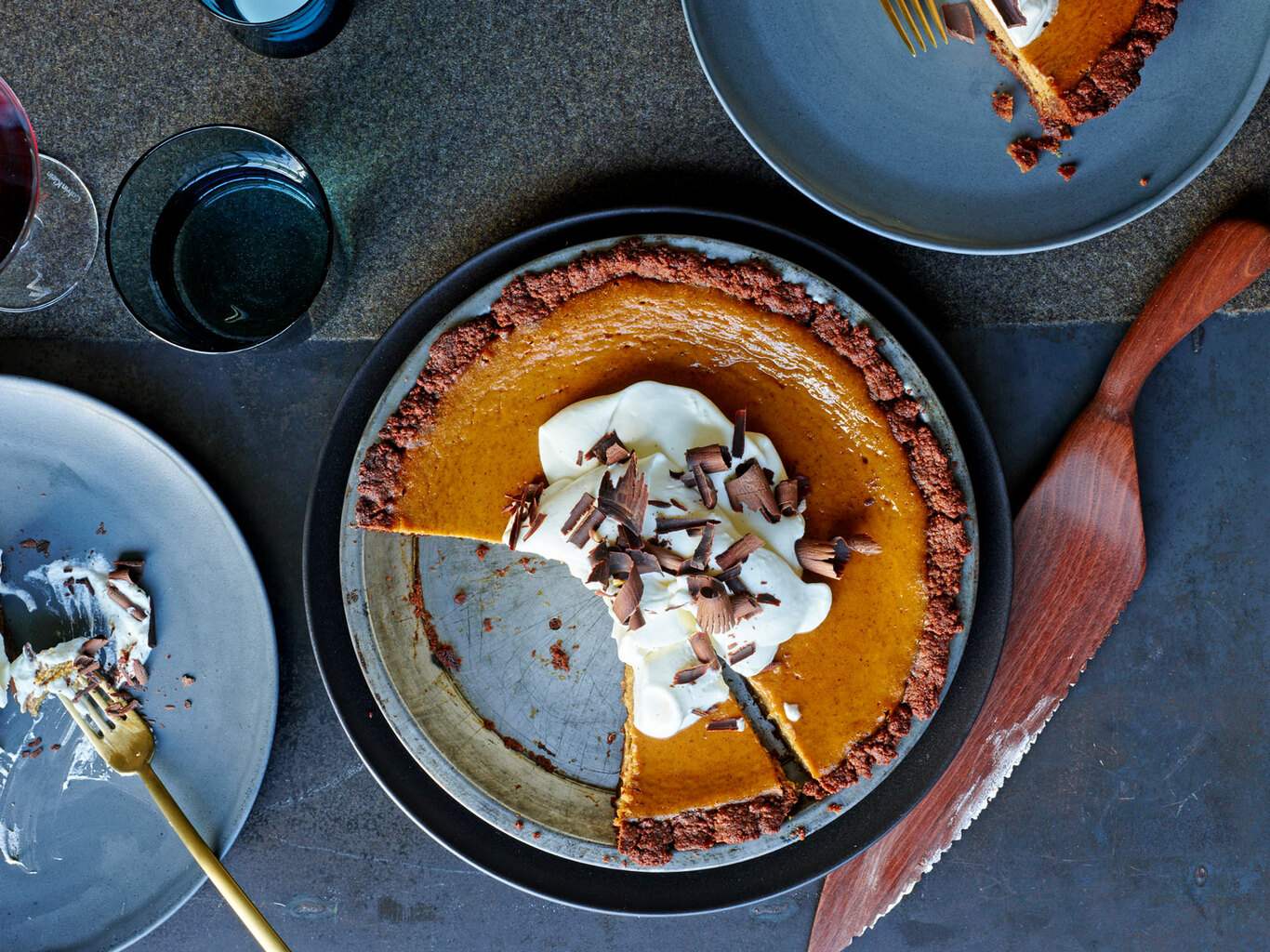Cinnamon, ginger, nutmeg, allspice, clove. You know fall is officially here when these warm spices start seeping into everything from lattes to Spam. But spruced-up plays on the pumpkin spice blend don’t take away from the OG of Thanksgiving desserts: pumpkin pie.
“The key to a good pumpkin pie is not overthinking it,” says Quality Meats’ executive pastry chef, Cory Colton. “There’s a reason why this recipe has been around for so long. It’s a really simple filling—you just play around with the flavors and amount of spice.”
So, why is it that a recipe so straightforward—essentially pumpkin, eggs, sweetened condensed milk, sugar and spices—is one of the easiest to mess up?
“Sometimes, when recipes like pumpkin pie are so simple, I try and get creative and make substitutions and end up with Frankenstein concoctions that aren’t so great,” admits Colton. “Be patient. It’s not the end of the world if it doesn’t come out perfect—and whipped cream goes a long way in covering up mistakes.”

Colton was raised in the rural town of Rumford, Maine (population 5,700) and grew up watching his grandmother in the kitchen. She was the baker in the family, and he’d crouch over her shoulder, peering curiously from a step stool as she stirred a pot of molten sugar for her holiday fudge. The chef went on to train at the Culinary Institute of America and perfected his pastry techniques interning under Kelly Bailey at The Trellis in Williamsburg, Virginia. He passed through the pastry kitchen of The St. Regis Aspen Resort and Olives (also in Aspen) before moving on to Quality Meats in New York.
While he’s fine-tuned his techniques in some of the country’s most prestigious—and challenging—kitchens, he still comes back to his grandmother’s recipes when he’s looking for inspiration. “Her recipes are interesting because they’re from a period of time when people were poorer and couldn’t afford ingredients like butter and cream,” he says, realizing now that many of those desserts double as vegan options.
It’s thanks to this kind of resourcefulness that Colton has built up a slight reputation as a master of repurposing. When you’re sick of pumpkin pie, for example, chop and freeze your leftovers, throw them in a blender with ice cream, and voilà—a brand-new dessert with the same holiday feel. But first, you’ve got to start by baking the actual pie. And if you’ve been beating yourself up every time your filling sinks like a crater into the pie crust when it’s cooling, we’ve got five quick fixes that’ll help take your pies from basic to bakery-worthy, so they’re looking perfect every time they pop out of the oven.
Always blind bake your pie crust.
If the bottom of your pie crust is often raw and flimsy instead of firm and crispy, you’re not alone. “One of the most common mistakes is not blind baking (pre-baking) the crust without the filling,” says Colton. “With any kind of custardy, wet filling, you want to make sure the pie crust is almost fully cooked before you bake it with the actual filling so the bottom isn’t too soggy.”

Skip the standard KitchenAid mixer.
If you use a conventional KitchenAid mixer to beat the filling, mix it a second time around with a hand blender, or beurre mixer.
“It does a couple of things: It removes the air that got whipped in and it makes the filling silky smooth so you don’t have to strain it,” the chef says. “You don’t want any added air when you’re baking the pie because the air will cause the filling to puff up and soufflé, becoming dome-shaped, and when the pie cools, it sinks back down and shrinks a bit, so it cracks—and I know people get frustrated when they have big cracks in their pies.”
Opt for a cooler oven.
“There’s nothing wrong with baking a pie at a lower temperature for a longer amount of time, but if you bake it too high, it will brown too much and the filling may not be thoroughly cooked,” the chef says. The sweet spot is 300 degrees for about 45 minutes. How to test if your pie is ready? “Jiggle it,” Colton says. “If the very center of the pie isn’t moving around, if it’s set in place, you know it’s good to go.”

Don’t be scared of substitutions.
When doing dessert prep a few days ahead of time, a couple tablespoons of apple cider vinegar in place of water are key to preventing dough from oxidizing and turning gray. If you’re concerned about dairy issues, substitute the same amount of butter the dough calls for with vegan butter substitute or shortening, and coconut milk for sweetened condensed milk in the filling. Canned pumpkin may sound like cheating, but it’s a time-saver if you can’t roast your own (and it’s usually more consistent in texture, too).
“Flavor-wise, I’ve been substituting muscovado sugar in a lot of my fall desserts,” Colton says. “If you get it unrefined, it has licorice and toffee notes, so it pairs well with autumn spices. Plus, it’s an easy switch, since you can substitute cup-for-cup.”

Sweeten your whipped cream.
“Making whipped cream is so easy, but people don’t think to dress that up—and it’s simple,” Colton says. “Rather than using regular sugar to sweeten the whipped cream, I add maple sugar. You can also add a splash of bourbon, and that goes really well with pumpkin filling. And, if you want to do a play on egg nog, add freshly grated nutmeg.”
This article was written by Lane Nieset from Food & Wine and was legally licensed through the NewsCred publisher network. Please direct all licensing questions to legal@newscred.com.








